In the wake of the dissolution of the Lower House in November 2012 and the subsequent general election that gave birth to the new government led by Shinzo Abe, the president of the Liberal Democratic Party who advocated monetary easing, the yen has depreciated significantly, not only against major currencies including the U.S. dollar, but also against Asian currencies that are loosely linked to the dollar (Figure 1). The depreciation of the yen has raised expectations for the recovery of the Japanese economy—which had fallen into long-term stagnation—driven by the stronger export competitiveness of Japanese companies. As a result, share prices in the Tokyo stock market have been rising significantly.
Change in Yen Exchange Rates against the U.S. dollar, Chinese renminbi (RMB), and Korean won
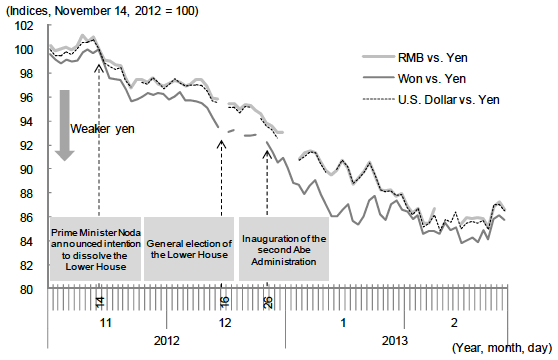
On the other hand, there is criticism overseas that a weaker yen is a kind of beggar-thy-neighbor policy. While it is true that the export competitiveness of Asian countries will fall if the yen weakens, it should not be forgotten that the prices of machinery and components imported from Japan and, in turn, production costs in these countries will also decline. The negative impact on exports will be greater than the positive impact on imports for countries that are in a competitive relationship with Japan, such as South Korea, while the reverse is true for those that are in a complementary relationship with Japan, such as China.
Complementarity or competitiveness with Japan will determine the outcome
If the yen weakens, Japan's export prices will fall in dollar terms and, in turn, in Asian currency terms. For Asian countries, this means that the competitiveness of their products against their Japanese counterparts will worsen on the demand side, while the price of imports from Japan will fall on the supply side.
Considering the impact of a weaker yen on the demand side, an Asian country's loss of market share to Japan in third countries is even more important than the contraction of its exports to Japan. Those countries that will see their competitiveness seriously decline include newly industrialized economies (NIEs)—countries and regions such as South Korea whose export structure (focusing on high-tech products) is similar to that of Japan. For example, South Korea barely exports any automobiles—its major export product—to Japan, but its overall exports and, in turn, its economic growth will be held down if the yen weakens as its exports to other markets such as Europe and the United States will decrease. On the other hand, China and the Association of Southeast Asian Nations (ASEAN) countries do not compete intensively with Japan, as their export structures greatly differ. Even if the yen depreciates, the international market share made up of the labor-intensive products in which these countries excel will not be lost to Japanese products.
Meanwhile, on the supply side, a drop in the price of Japanese imports from a weaker yen means falling production costs for Asian countries, which could lead to expansion of production. This benefit of a weaker yen is greater for those countries that are in a complementary relationship with Japan, and for which Japan constitutes a large share of their imports.
Considering these demand and supply factors together, the impact on Asian countries of a weaker yen will be determined by whether the country in question is in a complementary or competitive relationship with Japan. A typical example of the former is China, while an example of the latter is South Korea (Figure 2).
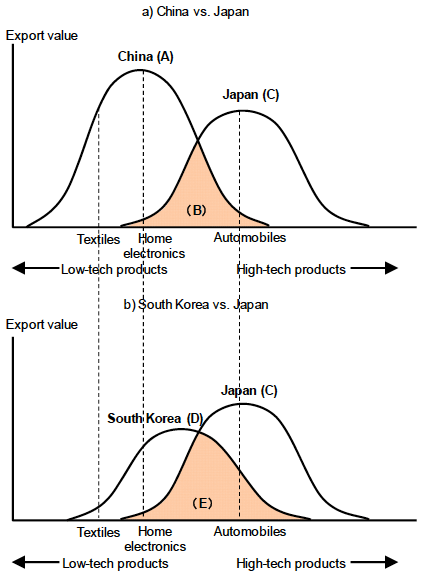
Analysis based on standard economic theory
In term of standard demand-supply analysis found in economic textbooks, the deterioration in the competitiveness of Asian countries associated with a weaker yen can be represented by a shift of the demand curve to the left, while the drop in import prices can be represented by a shift of the supply curve to the right (Figure 3a and Figure 3b respectively). In the international market, the former reflects the shift in demand to Japanese products from those of the country concerned. As a result, both the price level and production in that country will decline (bad deflation). On the other hand, the latter reflects the decline in production costs associated with the drop in the price of components and machinery imported from Japan. As a result, the country's price level will fall, but its production will increase (good deflation).
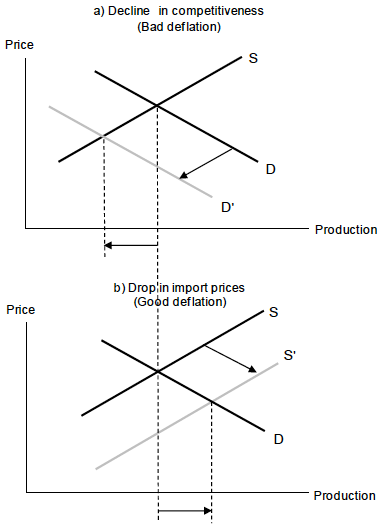
In addition, in the case of countries that are in a complementary relationship with Japan, such as China, the shift in the supply curve is greater than that in the demand curve, and therefore production will increase (Figure 4a). On the other hand, in the case of countries that are very competitive with Japan, such as South Korea, the shift in the demand curve is greater than that in the supply curve, and therefore production will contract (Figure 4b).
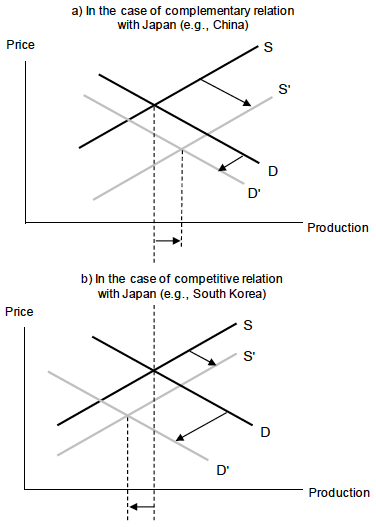
Asymmetrical response to the weaker yen in Asian stock markets
The movement of share prices in Japan, China, and South Korea also shows that a weaker yen is positive for the Chinese economy and negative for the South Korean economy (Figure 5). Share prices have been rising since mid-November 2012 in major global markets, including New York. Among them, the Tokyo market, which is expected to benefit from the weaker yen, has shown the greatest rise, and the rise in the Shanghai Composite Index is also greater than that in the Dow Jones Industrial Average. On the other hand, in South Korea, which is expected to receive the biggest blow from a weaker yen, the increase in share prices has lagged behind other markets.
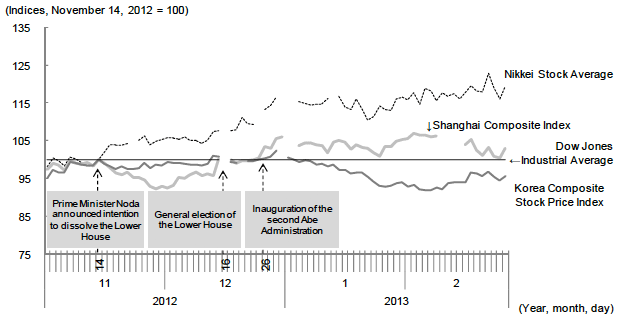
This movement in share prices, a leading economic indicator, suggests that the Chinese economy will remain relatively solid in 2013, while the Korean economy will stagnate.


